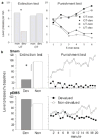On habits and addiction: An associative analysis of compulsive drug seeking
- PMID: 20582332
- PMCID: PMC2891067
- DOI: 10.1016/j.ddmod.2009.07.004
On habits and addiction: An associative analysis of compulsive drug seeking
Abstract
The processes that underlie the pathological pursuit of drugs in addiction and that support the transition from casual drug taking to their compulsive pursuit have recently been proposed to reflect the interaction of two action control processes that mediate the goal-directed and habitual control of actions for natural rewards. Here we describe the evidence for these learning processes, their associate structure and the motivational mechanisms through which their operation is translated into performance. Finally, we describe the potential changes in the interaction between habitual and goal-directed processes induced by drug addiction that subserve compulsive drug pursuit; i.e. the increase in habit learning and reduction in the regulation of habits induced by changes in the circuitry that mediates goal-directed action.
Figures



Similar articles
-
Addiction is driven by excessive goal-directed drug choice under negative affect: translational critique of habit and compulsion theory.Neuropsychopharmacology. 2020 Apr;45(5):720-735. doi: 10.1038/s41386-020-0600-8. Epub 2020 Jan 6. Neuropsychopharmacology. 2020. PMID: 31905368 Free PMC article. Review.
-
Habitual alcohol seeking: modeling the transition from casual drinking to addiction.Neurosci Biobehav Rev. 2014 Nov;47:281-94. doi: 10.1016/j.neubiorev.2014.08.012. Epub 2014 Sep 2. Neurosci Biobehav Rev. 2014. PMID: 25193245 Free PMC article. Review.
-
Dopamine receptors in the learning, memory and drug reward circuitry.Semin Cell Dev Biol. 2009 Jun;20(4):403-10. doi: 10.1016/j.semcdb.2009.01.002. Epub 2009 Jan 20. Semin Cell Dev Biol. 2009. PMID: 19560045 Review.
-
Behavioral and neural mechanisms underlying habitual and compulsive drug seeking.Prog Neuropsychopharmacol Biol Psychiatry. 2018 Dec 20;87(Pt A):11-21. doi: 10.1016/j.pnpbp.2017.09.003. Epub 2017 Sep 5. Prog Neuropsychopharmacol Biol Psychiatry. 2018. PMID: 28887182 Free PMC article. Review.
-
Actions, action sequences and habits: evidence that goal-directed and habitual action control are hierarchically organized.PLoS Comput Biol. 2013;9(12):e1003364. doi: 10.1371/journal.pcbi.1003364. Epub 2013 Dec 5. PLoS Comput Biol. 2013. PMID: 24339762 Free PMC article.
Cited by
-
Non-nociceptive roles of opioids in the CNS: opioids' effects on neurogenesis, learning, memory and affect.Nat Rev Neurosci. 2019 Jan;20(1):5-18. doi: 10.1038/s41583-018-0092-2. Nat Rev Neurosci. 2019. PMID: 30518959 Free PMC article. Review.
-
Bi-directional modulation of food habit expression by the endocannabinoid system.Eur J Neurosci. 2019 Jun;49(12):1610-1622. doi: 10.1111/ejn.14330. Epub 2019 Jan 11. Eur J Neurosci. 2019. PMID: 30589475 Free PMC article.
-
Translational Research on Habit and Alcohol.Curr Addict Rep. 2016 Mar;3(1):37-49. doi: 10.1007/s40429-016-0089-8. Epub 2016 Feb 3. Curr Addict Rep. 2016. PMID: 26925365 Free PMC article.
-
Contextual control of chained instrumental behaviors.J Exp Psychol Anim Learn Cogn. 2016 Oct;42(4):401-414. doi: 10.1037/xan0000112. Epub 2016 Sep 5. J Exp Psychol Anim Learn Cogn. 2016. PMID: 27598060 Free PMC article.
-
Brain region-specific neuromedin U signalling regulates alcohol-related behaviours and food intake in rodents.Addict Biol. 2020 May;25(3):e12764. doi: 10.1111/adb.12764. Epub 2019 May 8. Addict Biol. 2020. PMID: 31069918 Free PMC article.
References
-
- Everitt BJ, et al. Associative processes in addiction and reward. The role of amygdala-ventral striatal subsystems. Ann N Y Acad Sci. 1999;877:412–438. - PubMed
-
- Everitt BJ, Robbins TW. Neural systems of reinforcement for drug addiction: from actions to habits to compulsion. Nat Neurosci. 2005;8 (11):1481–1489. - PubMed
-
- Tiffany S, et al. What can dependence theories tell us about assessing the emergence of tobacco dependence? Addiction Suppl. 2004;1:78–86. - PubMed
-
- Dickinson A. Actions and habits: the development of behavioural autonomy. Philosophical Transactions of the Royal Society of London. 1985;B308:67–78.
Grants and funding
LinkOut - more resources
Full Text Sources
